
- Home
- Memories
- Scrapbook ▽
- Topics ▽
- People ▽
- Events
- Photos
- Site Map
- Timeline
Page updated 6th February 2023
Also see Bridges of Exeter
There have been five known, permanent bridges across the Exe since the middle ages. Some historians think there may have been a Roman, stone built bridge, but no archeological evidence has been found for such a structure. It is known that during the Roman and Anglo Saxon times, the river was tidal and much wider and shallower, so that animals and carts crossed via a ford at low tide. There is some evidence from written accounts for a rickety, wooden walkway for pedestrians.
The first stone bridge was complete about 1238, by Nicholas and his son, Walter Gervaise, who was four times Mayor of the city and who died in 1259. They raised the money through a public subscription - Walter went to friends and wealthy and influential citizens requesting funds for the new crossing. He raised enough to not only build the bridge, but to purchase properties whose income provided money for maintenance. The bridge was in fact started as far back as 1190. Built from volcanic stone quarried from Northernhay, near the castle, it had 18 arches and a chapel at each end, and was probably the third stone bridge to be completed in England, the first being London Bridge.
Because the bridge was narrow, there were recesses over each pier for pedestrians to wait, while a cart or animals crossed. Indeed, farmers would have driven herds of cattle across the bridge to market. As was common at this time, there were houses built over the bridge - they can be clearly seen in the print on the right. A church dedicated to St Edmund's was built over two of its arches at the eastern end, and one to St Thomas at the western end.
By the middle of the 15th Century, the bridge was in some disrepair. John Shillingford, Mayor of Exeter 1447-50, petitioned for funds to repair the bridge, after he recalled the horrific sinking of the ferry, that crossed the Exe, before the Garvaise bridge was constructed.
"Where of longe tyme and wythynne tyme of mynde was another brigge no way but by right a perillous fery bote; by which tyme were yn grete perill and meny perished and lost".
Many ferry passengers were drowned, which prompted Walter Gervaise to build the Exe Bridge.
St Edmund's Church had been extensively remodelled in 1832 and the roadway widened in 1854. When the road system around the west side of Exeter was remodelled in the 1960s and 1970s, the ancient street that ran along the top of the medieval Exe Bridge to the the site of the West Gate, was removed. The contractors discovered the remains of eight arches at the eastern end of the old medieval bridge. Archeologists were called in and it was excavated, the Victorian tower of St Edmunds saved, and both opened to the public in the middle of a busy road system. It is now the oldest surviving medieval arched stone bridge in England.
In the 18th century, the western half of the medieval bridge crossing the main river was demolished and replaced by a new bridge 25 feet wide, lined up with Fore Street. Jenkin's chronicled the problems encountered in building the bridge.
".... accordingly a plan was drawn for building a New Bridge, in a line from the bottom of Fore-street, across part of Exe-Island, a little above the old one; the expences to be paid by an additional toll at the turnpikes. An act of parliament having been passed for this purpose, the first stone was laid October 4th, 1770, …in the presence of many thousand spectators …. and the building proceeded with great rapidity, when an unlucky accident put a stop to it: the arch on St. Thomas's side was completely finished, and the greater part of the centre arch turned, when suddenly, a flood happening, the whole fell down, owing to the negligence of the Architect, in not having a proper foundation for the piers, and not striking the centres, which penning back the water caused a great pressure on the piers … This disaster not only greatly increased the expence, but put a stop to the building, as it required much time to recover the stones which had fallen into deep water. Mr Dixon being discharged from the work, Mr. John Goodwin w…ho had been an assistant to the former, undertook to complete the work. ... he proceeded in a very different manner: he turned the course of the river by erecting a strong dam and cutting a canal at the foot of the Old Bridge; and to prevent the water from penning back, he caused another bay to be built below the first; and then, by the assistance of chain and other pumps, he effectually cleared the bed of the river, and laid a firm foundation on the solid rock."
It was opened in 1778, along with a new approach from the city, down New Bridge Street. The new line and entrance to the city made a much easier route into the centre, especially for pack-animals and heavily laden carts and coaches. Work had started in 1770 to build the new, three arched bridge, but when work was commencing at a good pace, storms in March 1774 and January 1775 caused great torrents on the Exe which swept the partly built structure away. Once the stones had been retrieved, a new foundation stone was laid on 15th July 1776, by Chancellor Nutcombe. By 1778 the bridge was completed at a cost of £30,000 and opened. The first traffic across was a funeral cortège. In 1811 measures were taken to protect the bridge from the ravages of flooding. The Georgian bridge lasted until 1903 when a temporary wooden footbridge was constructed and the old bridge demolished to make way for a new steel and cast iron bridge.
In 1905 a new, stronger and flatter cast-iron and steel bridge was completed and opened on 29th March 1905 by the Mayor, Councillor C Perry. The opening was attended by a large crowd, with some climbing onto roofs to view the ceremony. A rope was stretched across the roadway which was cut by the Mayor.
As the new bridge was to be on the same site as the old Georgian bridge, a temporary wooden footbridge was constructed on the southern side. Then during 1903/4 the old bridge was demolished. The new bridge was designed by Sir John Wolfe Barry, and cost £25,000. The bridge was based on what is known as the 'three hinged arch', which for the time gave the flattest bridge then in existence in the country. It weighed a total of 430 tons with a 110 ton parapet. The construction was designed to withstand expansion and contraction caused by fluctuating temperature. An extended tram system was installed to St Thomas with a new line to Alphington, following in 1906. This bridge lasted for some 70 years, when, after the floods of 1960 twice covered St Thomas on the west bank, it was decided to replace it as the structure tended to hold high water back and increase the chance of flooding. This bridge had elegant lamps to light the way - when the bridge was demolished, two were moved to the quay and now mark the opposite sides of the river, where Butt's Ferry operates.
On demolition, parts of the Exe Bridge were stored at the council depot at Belle Isle. These included the ornate central lamps and associated fittings. The two half arches went for scrap.
Thomas Sharp in his book, the Exeter Phoenix proposed a northern by-pass to meet up with the Exe Bridge at a cloverleaf junction. He had no proposal for replacing the bridge, and it was not until the 1960 floods, that the inadequacy of the 1905 bridge, to allow a large quantity of flood water to pass beneath, that plans were put into place to replace it.
By 1969 the new north bridge was completed and opened by Mayor Bill Hallett on a sunny day in July, who then rode across in the Mayors car. The south bridge was opened in 1972, allowing the 1905 bridge to be demolished. These twin bridges are strictly functional, built out of concrete and forming, between them, a large roundabout system, that at times, seems to be permanently jammed. The piers have been designed to aid the flow of water during flood and the banks of the Exe have been concreted, also to aid water flow. There is no trace of the Georgian or 1905 bridge left.
Many houses and businesses have also been demolished around the bridges, opening up the area, with grassy banks. Unfortunately, on the eastern bank, by the northern bridge is one of Exeter's ugliest and most insensitive buildings, Renslade House.
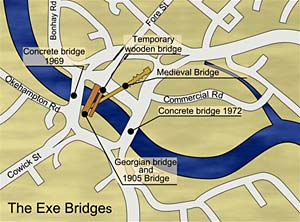 Map of the Exe Bridges
Map of the Exe Bridges
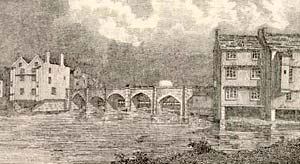 The medieval Exe Bridge - completed in 1238
Courtesy Devon Library and Information Services
The medieval Exe Bridge - completed in 1238
Courtesy Devon Library and Information Services
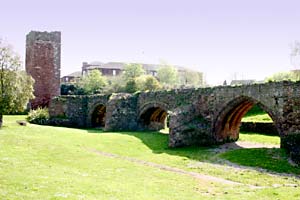 The medieval Exe Bridge and St Edmunds Tower - excavated remains 2004
The medieval Exe Bridge and St Edmunds Tower - excavated remains 2004
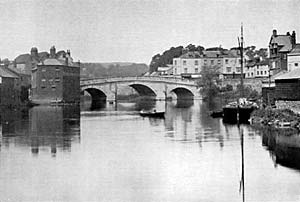 The Georgian Exe Bridge looking north - completed 1778
The Georgian Exe Bridge looking north - completed 1778
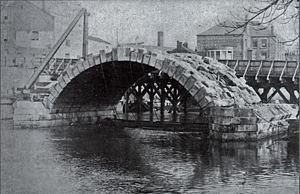 The temporary footbridge is behind the partly demolished bridge.
The temporary footbridge is behind the partly demolished bridge. 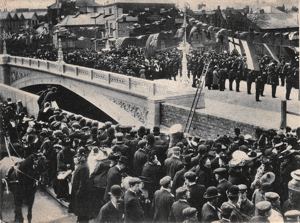 The opening of the Exe Bridge in 1905 by Mayor Perry. The temporary footbridge is in the foreground.
The opening of the Exe Bridge in 1905 by Mayor Perry. The temporary footbridge is in the foreground. 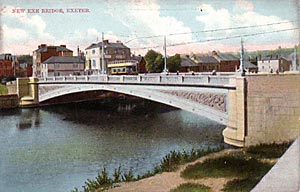 The 1905 Exe Bridge - built of cast-iron and steel.
The 1905 Exe Bridge - built of cast-iron and steel. 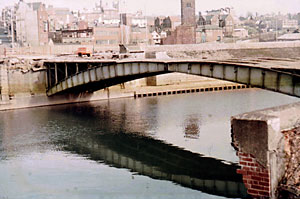 The exposed steel cantilevers of the three hinged arch, of the 1905 Exe Bridge, before they were demolished. Photo by Alan H Mazonovicz.
The exposed steel cantilevers of the three hinged arch, of the 1905 Exe Bridge, before they were demolished. Photo by Alan H Mazonovicz.
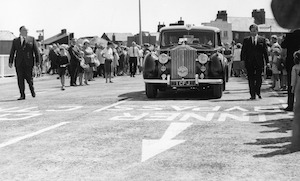 The Mayor's Car. Photo by Ralph Binding
The Mayor's Car. Photo by Ralph Binding
│ Top of Page │